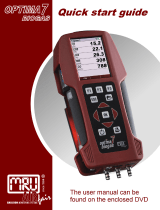
Table of contents
1. Safety instructions .................................................................................................................................................. 5
1.1 Warnings .......................................................................................................................................................... 5
1.2 Environment protection .................................................................................................................................... 5
1.3 Symbols used ................................................................................................................................................... 5
2. Introduction ........................................................................................................................................................... 6
2.1 Analyzer description ......................................................................................................................................... 6
2.2 Main features ................................................................................................................................................... 7
2.3 Conformity and standards ................................................................................................................................ 9
2.3.1 FCC rules ................................................................................................................................................. 9
2.3.2 Canadian standard ................................................................................................................................... 9
3. First Start-up ........................................................................................................................................................ 10
4. Features ............................................................................................................................................................... 11
4.1 General features ............................................................................................................................................. 11
4.2 Dimensions .................................................................................................................................................... 11
4.3 Parameter specications ................................................................................................................................. 12
5. Perform a ue gas analysis...................................................................................................................................13
5.1 Prepare the instrument before the analysis ...................................................................................................... 13
5.2 Perform a gas analysis .................................................................................................................................... 13
5.3 Save the analysis ............................................................................................................................................ 14
5.4 Print the analysis results ................................................................................................................................. 14
6. Set the general parameters of the analyzer .......................................................................................................... 15
6.1 Set the time ................................................................................................................................................... 15
6.2 Set the time zone ........................................................................................................................................... 15
6.3 Set the date ................................................................................................................................................... 15
6.4 Set the language ............................................................................................................................................ 15
6.5 Set the country ............................................................................................................................................... 15
6.6 Set the autozero ............................................................................................................................................. 15
6.7 Set the purge time .......................................................................................................................................... 16
6.8 Set the self-extinction ..................................................................................................................................... 16
6.9 Set the brightness of the screen ...................................................................................................................... 16
6.10 Reset to factory setting ................................................................................................................................. 16
7. Set the parameters of the analysis ....................................................................................................................... 17
7.1 Set the fuel .................................................................................................................................................... 17
7.1.1 Create a fuel .......................................................................................................................................... 18
7.2 Set the CO pump cut-off level ......................................................................................................................... 18
7.3 Set the Reference O2 ...................................................................................................................................... 18
7.4 Set the NOx factor .......................................................................................................................................... 19
7.5 Set the Smoke/soot index ............................................................................................................................... 19
7.6 Set the alarms ................................................................................................................................................ 19
7.7 Zero draft sensor ............................................................................................................................................ 20
7.8 Set the atmospheric pressure .......................................................................................................................... 20
7.9 Set the air temperature ................................................................................................................................... 20
7.10 Set the display conguration ......................................................................................................................... 21
8. Set the measuring unit ......................................................................................................................................... 22
9. Set the printer ...................................................................................................................................................... 23
9.1 Set the printer connection ............................................................................................................................... 23
9.2 Set the number of copies ................................................................................................................................ 23
10. Analyzer information ......................................................................................................................................... 24
10.1 Service and Calibration ................................................................................................................................. 24
10.1.1 Calibration information ......................................................................................................................... 24
10.1.2 Service center contact ........................................................................................................................... 24






















